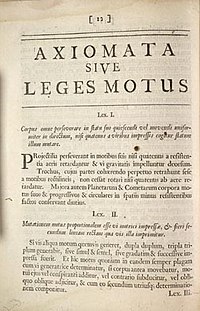Navigation
Install the app
How to install the app on iOS
Follow along with the video below to see how to install our site as a web app on your home screen.
Note: This feature may not be available in some browsers.
More options
Style variation
You are using an out of date browser. It may not display this or other websites correctly.
You should upgrade or use an alternative browser.
You should upgrade or use an alternative browser.
Foulcault pendulum
- Thread starter MaryL
- Start date
Old Rocks
Diamond Member
Inertia. The pendulum will continue in the same motion until an outside force changes it's direction. The earth turns underneath it, it is not connected to the earth except a the connection of the wire, the rotation of the earth has not effect on the pendulum.
Newton's laws of motion
From Wikipedia, the free encyclopedia
For other uses, see Laws of motion.

Newton's First and Second laws, in Latin, from the original 1687Principia Mathematica.
Classical mechanics
{\displaystyle {\vec {F}}=m{\vec {a}}}

Second law of motion
Branches[show]
Fundamentals[show]
Formulations[show]
Core topics[show]
Rotation[show]
Scientists[show]
Newton's laws of motion are three physical laws that, together, laid the foundation for classical mechanics. They describe the relationship between a body and the forces acting upon it, and its motion in response to those forces. They have been expressed in several different ways, over nearly three centuries,[1] and can be summarised as follows.
First law: When viewed in an inertial reference frame, an object either remains at rest or continues to move at a constant velocity, unless acted upon by a net force.[2][3]
Second law: In an inertial reference frame, the vector sum of the forces F on an object is equal to the mass m of that object multiplied by the acceleration vector a of the object: F = ma.
Third law: When one body exerts a force on a second body, the second body simultaneously exerts a force equal in magnitude and opposite in direction on the first body.
Newton's laws of motion - Wikipedia, the free encyclopedia
Newton's laws of motion
From Wikipedia, the free encyclopedia
For other uses, see Laws of motion.

Newton's First and Second laws, in Latin, from the original 1687Principia Mathematica.
Classical mechanics
{\displaystyle {\vec {F}}=m{\vec {a}}}

Second law of motion
Branches[show]
Fundamentals[show]
Formulations[show]
Core topics[show]
Rotation[show]
Scientists[show]
Newton's laws of motion are three physical laws that, together, laid the foundation for classical mechanics. They describe the relationship between a body and the forces acting upon it, and its motion in response to those forces. They have been expressed in several different ways, over nearly three centuries,[1] and can be summarised as follows.
First law: When viewed in an inertial reference frame, an object either remains at rest or continues to move at a constant velocity, unless acted upon by a net force.[2][3]
Second law: In an inertial reference frame, the vector sum of the forces F on an object is equal to the mass m of that object multiplied by the acceleration vector a of the object: F = ma.
Third law: When one body exerts a force on a second body, the second body simultaneously exerts a force equal in magnitude and opposite in direction on the first body.
Newton's laws of motion - Wikipedia, the free encyclopedia
MaryL
Diamond Member
- Thread starter
- Banned
- #3
They have always blown me away, Now I feel like an idiot for not understanding the basic physics behind how the pendulum shows the earth's rotation. Plus, they they are cool to watch. You can find one in just about any large planetarium or museum in your area.
Similar threads
- Replies
- 11
- Views
- 585
- Replies
- 18
- Views
- 570
New Topics
-
-
-
US aid cuts leave food for millions mouldering in storage
- Started by C_Clayton_Jones
- Replies: 8
-
DHS Exploring Reality TV Show Where Migrants Compete For Citizenship
- Started by EvilEyeFleegle
- Replies: 3
-
DOGE went looking for phone fraud at SSA -- and found almost none
- Started by C_Clayton_Jones
- Replies: 5